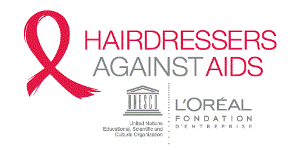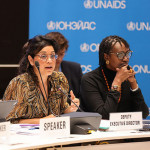Before I got HIV, my birthday and New Year’s Eve were the main moments I stopped and reflected about what had come before and how I could better shape the future. But since the virus set up shop in my immune system, World AIDS Day is when I am most deeply reflective.
I am so sad for the massive loss our global community has suffered. I am so grateful, though admittedly sometimes guiltily, for my own survival. And I am determined to work as many hours as my body will allow me to stay awake to fight this horrible disease, both inside myself and in the world at large.
With each year that passes (I now head into my 15th year of survival) I am more energized and more resolved than ever that we can do this. We can de-stigmatize HIV/AIDS. We can get people to get tested. We can do a better job of awareness, education and prevention. We can improve access to care for people around the world. We can develop a vaccine--and a cure.
We cannot give up.
But I also acknowledge the difficulties we face. We are at a critical fulcrum point. As we head into the 30th year of AIDS, we face massive funding challenges, the stigma is still really bad and deadly and the myths, misperceptions and lack of awareness and education threaten to undermine the progress that’s been made. People are fed up, tired and ready to move on to easier fights.
Recently, Germany deprioritized HIV as a health concern for their nation. I am concerned that people are beginning to see the scope of the challenges presented by HIV as insurmountable and walk away or focus elsewhere so that if we fail to stop the pandemic, it won’t be “their fault.” But of course, it will be the fault of any one or any nation who turns their back on HIV now. I was very happy and relieved to hear Dr. Tom Frieden, head of the U.S. Centers for Disease Control and Prevention recently name HIV as one of six “winnable battles” the CDC will wage. And I have been grateful for President Obama’s continued support of HIV/AIDS. Though we cannot stop advocating--demanding--that he keep his campaign promises about fiscal support for AIDS, we must also recognize the additional funding that has been given to HIV in a time of economic crisis. No, it is not enough, but it is a start.
I have sounded like a broken record advocating for the importance of upping the ante now to break the cycle of infection and death and the cost HIV wrings from the planet in terms of human lives and currency. While I absolutely recognize the challenges of spending more money on anything in fiscally restricted times, the danger of not finding the resources we need to try to stop AIDS means we will pay massively, exponentially more in the future.
It is not okay that more than 4,000 Americans living with HIV are on AIDS Drug Assistance Program (ADAP) wait lists. And it is not okay that we totally failed to meet the Millennium Development Goal of Universal Access and that millions of people’s lives are imminently at risk for death despite the fact that we have the drugs that can save their lives. We must find an economic solution that gets more pills to more people in a way that still allows the pharmaceutical companies who manufacture them to be profitable. Because they are for profit businesses and the best shot we have at ensuring their continued investment is to make it fiscally worth their while to continue to invest in the production and distribution of antiretroviral drugs globally. BUT, we must also encourage them to reinvest in new solutions, and in vaccine and cure research.
In times when money is tight, we also need to get creative. We need to work together. We need to make hard decisions. We need to find innovative solutions.We can be more efficient with dollars spent on AIDS. We can have more impact with the money we have. The National HIV/AIDS Strategy and the coordinated efforts it demands could help with this.
Next monday, I head to DC to speak at the Funders Concerned About AIDS conference where I will moderate a panel that will look at how private sector investment can get the most bang for the bucks spent on fighting HIV/AIDS.
 Yesterday, I spoke at the United Nations at the U.S. launch of L’Oreal’s “Hairdressers Against AIDS” campaign. The campaign engages thousands of hairdressers’ help to educate people about preventing, getting tested for and seeking care for HIV. It’s a great example of how a corporation can leverage an existing structure and workforce to support public health. And it’s proof that the Global Business Coalition to Fight TB, Malaria and AIDS is a good idea. The GBC member companies (L’Oreal is one) use the resources they already have to help fight HIV/AIDS. It’s an efficient way to save lives.
Yesterday, I spoke at the United Nations at the U.S. launch of L’Oreal’s “Hairdressers Against AIDS” campaign. The campaign engages thousands of hairdressers’ help to educate people about preventing, getting tested for and seeking care for HIV. It’s a great example of how a corporation can leverage an existing structure and workforce to support public health. And it’s proof that the Global Business Coalition to Fight TB, Malaria and AIDS is a good idea. The GBC member companies (L’Oreal is one) use the resources they already have to help fight HIV/AIDS. It’s an efficient way to save lives.
And the week prior, I met with Ambassador Eric Goosby, the U.S. Global AIDS Coordinator (look for his video up on poz.com shortly) to discuss how the President’s Emergency Fund for AIDS Relief (PEPFAR) is restructuring some of its programs to maximize the impact of U.S. dollars spent fighting HIV/AIDS around the globe.
In addition to a new focus on how we use the dollars we spend against HIV, there is also a big wave of global initiatives that are helping illuminate that AIDS is far from over and we need the general public to help pitch in too.
In a cool new AIDS awareness campaign called “Digital Life Sacrifice” sponsored by Alicia Key’s charity Keep A Child Alive, more than a dozen celebrities like Keys, Usher, Justin Timberlake, Lady Gaga and others have gone “dark” in social media to raise more funds for HIV/AIDS. They appeared in public service announcements in coffins saying they would stay off Twitter and Facebook until the campaign raised $1 million. It’s a great example of appealing to individuals to invest in the health of families living in India and Africa--families affected by HIV/AIDS.
Tonight, the UNAIDS campaign “Light for Rights” dims the lights of major landmarks around the world to remind the world that AIDS is far from over and that the safety, health and longevity of each person around the world is a basic human right. (Stay tuned for my interview with amfAR’s Chairman of the Board Kenneth Cole and Liza Minnelli!)
Over the last few days, as my email was flooded with a wave of messages from all over the world--including statements from everyone from the President of the United States to small AIDS service organizations in small towns--and press releases about all the new campaigns, activism and activity intended to put AIDS back on the map of cultural awareness, I allowed myself a glimmer of new found hope.
This morning in New York, a group led by Housing Works protested Mayor Bloomberg’s annual bagel breakfast for the HIV community due to the fact that the city has not passed legislation that will protect housing for people living with HIV and due to massive budget cuts for AIDS services. And D.C. Fights Back hosted a “Home is LIFE” rally at the Freedom Plaza this morning to demand a comprehensive plan to address the housing needs of homeless HIV positive people in the DC area. They were just two of many demonstrations that raged on today, aiming to intensify the conversation around HIV.
There is more noise, more activity, more energy than I have felt in past years. I almost don’t dare say it, but it seems like HIV/AIDS is back on the mainstream radar. On last Wednesday, the New York Times had two major stories about HIV/AIDS on its front cover, above the fold. “Study Finds New Pill Greatly Lowers The Risk of AIDS” and “Halting Disease Can Outweigh Ban on Condoms, Pope Says.” The two stories referred, respectively, to the release of data indicating an antiretroviral drug taken once daily by HIV-negative people could reduce HIV infection and the Pope’s new stance on condom use. Never, in all of my years, have I seen two AIDS stories side by side featured in such a prominent media vehicle. And the coverage continued. Yesterday, there was this New York Times story about the new breed of AIDS activists. (POZ was mentioned in the piece...a great sign that the mainstream media is connecting to the community!)
On the research front, It’s been a big year. We’ve seen significant advances in vaccine, cure and prevention science. There is new hope for microbicides.
We have a National HIV/AIDS Strategy, an implementation plan, and soon, an operational plan to put the strategy to work.
The travel ban for people with HIV entering the U.S. has been lifted.
The International AIDS Conference will be held in Washington, DC in 2012.
The Ryan White Care Act was extended.
Health care was reformed (though many won’t feel its benefits until 2014).
We are at a moment when the science has come far enough, the problem is bad enough, awareness is making a comeback and a new generation of young people is ready to step up so that if we apply more pressure, more innovative and more cold hard cash, we can make a quantum leap in the fight against HIV/AIDS.
The next year and a half leading up to the International AIDS Conference will be critical. When the world comes to America to talk about HIV, I want the U.S. community to have a great story to tell.
Last week, a big merger was announced--the National AIDS Fund and AIDS Action have joined forces and a new entity has been created called AIDS United.
I am eager to see what Mark Ishaug, soon-to-be-formerly-of the AIDS Foundation of Chicago and the new head of AIDS United will do in his new, big role.
One thing’s for sure: our community must unite for us to have a chance to beat down AIDS.
The domestic and global AIDS activists must work in concert to ensure access to care and treatment for people all over the globe, to help realize efficiencies, eliminate redundancies and to amplify the impact of each others competencies.
The HIV community must look also beyond itself to work together with other national and international organizations fighting for human, sexual and health rights. (Every single one of you reading this should fight for the repeal of “Don’t Ask, Don’t Tell” by calling Senator McCain’s offices in both DC and Arizona to demand that the Republicans do not squash this critical, landmark piece of legislation that will further ensure the rights of gay people willing to die for their country. Senator McCain’s office number is 202.224.2235 in DC; 602.952.2410 in Phoenix.)
The government, community, private industry and society at large must align against AIDS.
We can do it, if we do it together.
The best analogy I can think of for what must happen comes from the last time I saw a major hero--Randy Allgaier--who tragically passed away this past weekend.
I saw Randy this past summer at the reception for people living with HIV/AIDS hosted by President Obama at the White House.
At the reception, as I have chronicled in a previous blog, President and CEO of Housing Works Charles King interrupted the President’s speech by asking about housing for people with AIDS. At the end of his speech, the President approached Charles and spoke to him. Ever the journalist and eager to get it all on camera, I leaped up onto a White House chair.
I should have been worried about being gunned down by Secret Service as it did appear, for a moment, that I was lunging over the crowd towards the President.
Perhaps it was the pearls, or my pleated linen dress, but somehow, Secret Service decided I was no threat. But I still almost went down. I was wearing high heels and the chair was squishy and in my eagerness to record the historic conversation, I nearly fell backwards off the chair. Just as equilibrium started to go, I felt a firm hand grab the back of my knee and hold me up. I looked down.
It was Randy. Supporting me. Making sure I didn’t fall.
Unfortunately, I didn’t know Randy as well as I would have liked to. But in that moment of having Randy, a man whose relentless advocacy on the part of people with HIV has saved so many lives, grab my leg and keep me from toppling over, I felt that I was part of something much bigger than myself. I felt the communal bond that we all have with one another.
Though we may fight in different ways and sometimes focus on different things, we are all truly one community of people struggling to save our lives, our rights and to ensure that others’ lives are not at risk.
What struck me most about Randy was his attitude. Days before he left us, he was upbeat, fighting hard, staying strong. And all the while he was fighting for his own life, he focused on the needs of others.
Our bodies will fail us all one day. But the spirit of what we do while we inhabit our bodies fades slower and when it is a strong spirit like Randy’s, or that of so many others we have lost, it lingers and, I believe, lives on in those who are left behind.
So today, World AIDS Day, I ask you each to think about putting your hand on someone else to help them stand tall and continue the fight. If we all hold each other up, we will have a much better chance of ensuring that ultimately, far fewer fall.
I am grateful and inspired by all who survive HIV and all who fight with us.
I send you my love. And my gratitude.
Let’s let the future take us faster to a world without AIDS.
Advertisement
Advertisement
Advertisement







3 Comments
3 Comments